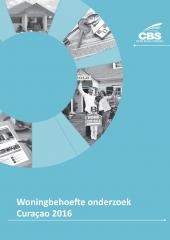Woningbehoefte onderzoek Curaçao 2016

Summary
The initial questions of this survey served to explore the survey population to deduce which factors/developments had driven the population’s demand for housing between 2008 and 2016. This revealed certain demographic developments within that period which played a significant role in the development of the housing demand, namely an increase in the number of households, accompanied by a decrease in household size.
Not to be ignored is an observed stagnation in the concession of long-lease plots which, while not affecting the market as a whole, does affect those sections of the market where there is a pronounced demand for self-built homes.
The housing demand was analyzed based on multiple variables and approaches. What follows is a brief list of aspects of the housing demand revealed in this survey.
- During the 2008-2016 period, housing demand increased to the present level of 16,160 dwellings (was 10,571 in 2008);
- While the housing demand increase was seen mainly in the 18-29 age group, it was not concentrated in this group, but spread out rather evenly instead over all age categories from 18 to 59 years of age (the demand is lower in the 60+ category);
- It should be added that the housing demand in the 18-29 age group’s relative importance is reduced once income is take into account (as due to a lack of income, fewer in this group are able to truly claim that their housing needs include an actual demand for housing);
- The housing demand is concentrated in the groups with a gross income of up to ANG 3000 per month, and this survey shows that 72% of the total number of those in need of housing belong to this group (the number of dwellings in demand for this group is estimated at 11,635), while 22% have middle-class incomes between ANG 3001 and Naf. 7000 per month (the housing demand for this group is estimated at 3555 dwellings) and 6% have higher incomes, ANG 7000+ per month (the housing demand for this group is estimated at 970 dwellings);
- Housing demand is the highest among unmarried women (38% of those in need of housing);
- The age groups experiencing the most pronounced need for housing are, in the income category of up to ANG 3000 per month, the 60+ age group (with incomes of up to ANG 999 per month) and the 18-29 age group (with incomes between ANG 1000 and Naf. 1999 per month);
- The age groups experiencing the most pronounced need in the income category of ANG 3000 or more are the 30-39 age group (with incomes between ANG 3000 and 3999 per month) and the 40-49 age group (with incomes between ANG 3000 and ANG 3999 per month).
- The persons in need of housing may be broken down by preferences into those who would like to rent (53%) and those who would like to own a dwelling (47%).
Persons in need of housing with a preference for renting:
The housing demand for rented houses is fairly evenly distributed across all age groups between 18-59 years of age. Those in need of housing in this group have a median income between ANG 1000-1999 per month and are looking for two or three-bedroom rental houses. Most of those in need of housing within this group state that they would like to pay up to ANG 250 for rent per month. Most of these (87%) would like a rental or “hire purchase” house from the FKP.
Persons in need of housing with a preference for ownership:
These persons in need of housing are found mainly in the 30-39 and 40-49 age categories, with incomes between ANG 1000 and ANG 2999 per month. Most of these persons in need of housing would like to pay ANG 1,000 per month for mortgage.
